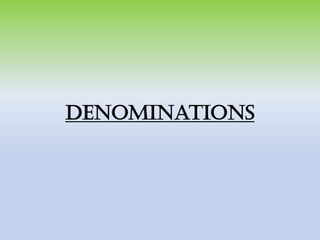Denunciar
Compartir

Recomendados
Recomendados
Religion - Lesson 1: Concept of Religon and Belief System

Religion - Lesson 1: Concept of Religon and Belief SystemPATRONAGE OF MARY DEVELOPMENT SCHOOL (PMDS)
Más contenido relacionado
La actualidad más candente
Religion - Lesson 1: Concept of Religon and Belief System

Religion - Lesson 1: Concept of Religon and Belief SystemPATRONAGE OF MARY DEVELOPMENT SCHOOL (PMDS)
La actualidad más candente (20)
JUDAISM - FORMATION, PRACTICES, RITUALS, AND BELIEFS

JUDAISM - FORMATION, PRACTICES, RITUALS, AND BELIEFS
Religion - Lesson 1: Concept of Religon and Belief System

Religion - Lesson 1: Concept of Religon and Belief System
Destacado
Destacado (20)
Presentation on business policy and business continuity plan (2)

Presentation on business policy and business continuity plan (2)
Demonetisation Hits & Misses: Indian & International Experience

Demonetisation Hits & Misses: Indian & International Experience
Similar a Denominations
Lesson 3 positive and negative effects of religion

Lesson 3 positive and negative effects of religionJustice Emilio Angeles Gancayco Memorial High School SHS
Similar a Denominations (20)
Pick one of the two topics below and post your responses.Choice .docx

Pick one of the two topics below and post your responses.Choice .docx
Lesson 3 positive and negative effects of religion

Lesson 3 positive and negative effects of religion
Religion & Ethics A very short introduction Dr. Bruce.docx

Religion & Ethics A very short introduction Dr. Bruce.docx
Más de NWsociology
Más de NWsociology (10)
Denominations
- 2. DENOMINATIONS are religious organisations that are midway between churches and sects. An example of this is Methodism. This is when they broadly accept society’s values, but they are not linked to the function of the state. This means that they can restrict their members, such as banning alcohol, but they do not restrict those who do not believe, and do not insist that their way is the one way of truth.
- 3. Denominations often form gradually. This can be the effect of historical events, culture, influence, power and geographic location. They can also happen rather rapidly, for example when somebody rather influential experiences something that questions their pattern of thought. Theories of existence, science etc. can really alter the way people believe, and form new versions of former religions.
- 4. Christian Denominations All of these different denominations still follow the same common name, structure, and doctrine (set of beliefs taught by a church or a group) within Christianity. The main differences between each denomination is that certain members have various doctrines about the Church and the story of Jesus Christ. Examples of denominations within Christianity are Catholics, Protestants, Anglicans etc. Eastern Orthodox and Oriental Orthodox churches are separate from western Christianity as they separate themselves geographically.